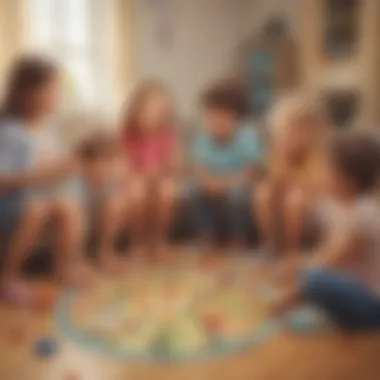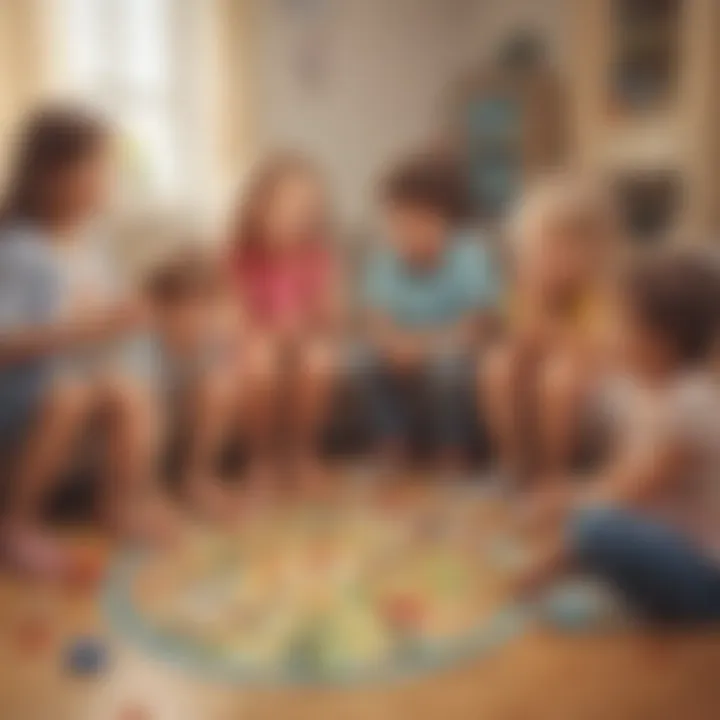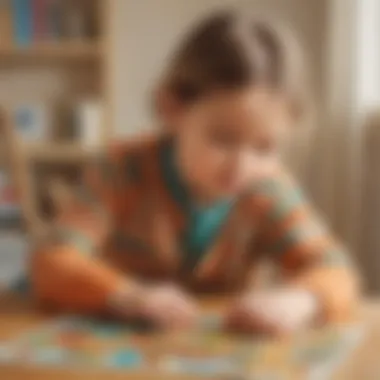Engaging Learning Games for 4-Year-Olds at Home


Intro
The early years of childhood are critical for the development of skills that lay the foundation for future learning. Engaging a four-year-old in learning games at home can significantly enhance their cognitive, physical, social, and creative abilities. This guide aims to provide parents and caregivers with insightful strategies to nurture these young minds through carefully selected activities that are easy to implement and enrich their daily routines. As we delve into different segments of this article, we will explore various thematic categories of games, each designed to further a child's development in meaningful ways.
Creative Activities
Craft Ideas
Engaging in craft activities is an excellent way for children to express their creativity and develop fine motor skills. Simple craft projects, such as creating paper animals or making a collage from magazine cuts, can be both fun and educational. Providing children with a range of materials like colored paper, glue, and scissors will allow them to experiment and create freely.
Step-by-Step Guides
To ensure that crafting sessions are productive, detailed instructions can be provided to guide children through each activity. For example, if creating a paper plate mask, begin with a list of materials needed:
- Paper plate
- Wiggly eyes
- Markers
- String Once materials are gathered, instructions can progress as follows:
- Decorate the paper plate with markers.
- Attach wiggly eyes with glue.
- Puncture holes on each side and add the string. By breaking down each project, children are less likely to feel overwhelmed.
Educational Value
Crafting offers multifaceted educational benefits. Through creativity, children enhance their problem-solving skills by brainstorming ideas. Completing a craft project builds confidence as they see their work come to fruition. Artfully, they develop hand-eye coordination crucial for other learning tasks.
Fun Quizzes
Quiz Topics
Having fun while learning can happen through quizzes that spark a child’s interest in various subjects. Topics from nature to math basics can cater to the breadth of knowledge a four-year-old can grasp. For instance, quizzes could explore questions like “What colors can you find in nature?” or “How do we count from one to ten?”
Question Types
Quizzes can include a variety of question types such as multiple-choice, true/false, and fill-in-the-blank. Such diversity ensures that children remain engaged and fosters critical thinking while acquiring foundational knowledge. Visual elements in these questions can boost comprehension, a valuable skill at this stage.
Knowledge Reinforcement
Through quizzes, learning becomes personalized. The interaction encourages children to recall information and reinforce what they have learned. When this activity occurs regularly, it supports memory retention and enhances comprehension skills that are crucial as they progress into higher educational levels.
Fact-Based Articles
Topics
Children's understanding of the world expands significantly through factual reading materials. Articles covering themes such as animals, space, and historical figures provide a wide scope of learning possibilities. Reading at this age, even playfully, introduces new vocabulary and concepts.
Engaging Content
The content should be accessible, allowing for comprehension sans frustration. Use of simple sentences and straightforward language enables children not only to grasp facts but also to enjoy the experience. Incorporating images alongside the text can liven the reading experience and help retain focus.
Understanding the Importance of Learning Games
Learning games are an essential part of childhood development, especially for four-year-olds. These activities are not just entertaining; they foster growth in various areas that help kids prepare for future learning experiences. By introducing structured play at this age, caregivers can lay the groundwork for cognitive, physical, and social skills that will support children's overall development.
Participants in these learning games are encouraged to engage, explore, and experiment. Such experiences play a critical role in how kids perceive their surroundings and gain understanding of the world. Through exploration and interaction with learning games, children can hone problem-solving skills and begin to form concepts that are vital for education.
Cognitive Development in Early Childhood
Cognitive skills refer to the mental capabilities needed to process information, develop language, and remember facts. At four years old, children require engaging activities that stimulate curiosity and promote active learning. Simple games such as puzzles or memory cards can help sharpen a child's ability to think critically and solve problems. They allow children to demonstrate their knowledge while reinforcing language development during play.
For instance, a memory game not only requires a child to recall card placements but also encourages communication. As children cooperate, they discuss strategies, bisect options, and learn from competitors, enhancing both logic and reasoning. Thus, these kinds of cognitive games serve to engage various mental faculties, preparing children for more complex tasks in the future.
Physical Development Through Play
Physical play is equally vital for four-year-olds. Engaging in activities promotes not only muscle development but also coordination and balance. Developing these skills at this stage aids in greater physical health in the years to come. Games such as role-playing or obstacle courses challenge a child's physical abilities, pushing them to refine movements and master body control.
When children participate in moving and dynamic learning activities, they practice gross motor skills, such as running and jumping, while also refining fine motor skills—like those necessary for grasping small objects. This holistic approach ensures balanced physical development, contributing to children's confidence in their bodies and fostering a lifelong appreciation for active play.
Social Skills and Emotional Growth
Integrating learning games into playdates or family gatherings can enhance social.skills significantly. Four-year-olds are inherently social beings, and giving them opportunities to interact through structured games fosters essential communication abilities. Collaborative activities not just allow kids to play together but also help them develop important concepts such as sharing, taking turns, and empathy.
The emotional aspect of play is evident through role-playing scenarios. As children express various characters and respond to different situations, they navigate their feelings and begin to understand emotional nuances. Play acting enables them to discuss feelings, encouraging empathy towards others while gaining confidence in emotional expression.


“Learning games connect children in ways that extend their cognitive, physical, and social development. Engagement in such play can create comprehensive growth that serves as a foundation.”
In summary, the importance of learning games for four-year-olds cannot be understated. These games aid in building a strong foundation for cognitive functions, physical acumen, and vital social skills. By integrating different types of learning games into a child's routine, caregivers can facilitate enriching growth experiences that prepare children for both educational and social settings ahead.
Types of Learning Games for Four-Year-Olds
Understanding the different types of learning games available for four-year-olds is crucial when developing a supportive learning environment at home. These games can target various developmental skills that are important at this age. Focusing on types of learning games offers a framework for parents and caregivers to implement activities that promote cognitive, motor, and social skills. It's essential to select games that align with a child's interests and learning style, ensuring engagement while fostering growth.
Cognitive Games
Cognitive games for children harness their ability to think and problem solve. Games like puzzles and memory matching help sharpen a child's memory, logical reasoning, and attention span. By engaging with tasks that require them to recall information or spot differences, children naturally enhance their cognitive skills. Activities such as dubbed
Simple Cognitive Games
Cognitive games play a vital role in early childhood education. For four-year-olds, their developing brain requires activities that challenge thinking processes. Simple cognitive games encompass a variety of tasks that enhance memory, problem-solving, and critical thinking. These games promote engagement while still being easy to facilitate at home. They not only stimulate cognitive skills but also encourage children to explore their capabilities in a fun environment.
Memory Matching Games
Memory matching games are a classic method to enhance a child's recall abilities. They center on presenting cards with illustrations or figures. Players take turns flipping over two cards, trying to match pairs. This activity builds concentration and strengthens memory skills as children learn to remember the location of each card.
Benefits:
- Enhances Memory: Helps children retain information through active engagement.
- Promotes Focus: Increases concentration as they strive to find matches.
- Encourages Turn-Taking: Fosters patience and a sense of fairness in play.
To implement this game, parents can create their own cards with household items or print out matching images. Customized memory matching also personalizes the learning experience, making it more relatable for the child. This sort of game supports cognitive education without complex rules.
Sorting and Categorizing Activities
Sorting and categorizing activities implement sorting objects by type, color, or size. This type of game promotes logical thinking and enhances observational skills. Children can engage with various materials around the house, encouraging tactile learning.
Key Advantages:
- Develops Organizational Skills: Sorting helps in understanding how to classify and group information in daily life.
- Enhances Vocabulary: Discussing categorizations adds to language development.
- Promotes Independence: Building confidence in making decision.
For example, parents can gather blocks, buttons, or fruits, and ask their child to sort these items based on different criteria. Such activities empower children while helping them grasp foundational concepts central to cognitive growth.
Engaging children in simple cognitive games not only lays the groundwork for important academic skills but also enriches their childhood experience.
Motor Skills Enhancement Activities
Motor skills enhancement activities are crucial to the overall development of four-year-olds. At this age, children are keen to develop their coordination, balance, and fine motor skills. Play-based activities improve physical abilities in a playful way, ensuring that children engage positively and productively. When children work on these skills, they gain confidence, which supports additional learning and exploration. By fostering motor skills, caregivers can prepare their children for various real-world tasks that can occur as they grow.
Improving motor skills can occur in two areas: gross motor skills and fine motor skills. Gross motor skills involve larger movements using arms and legs, while fine motor skills refer to smaller movements that require hand-eye coordination. Enhancing these skills not only remains fun for children but also reinforces critical cognitive connections in their developing brains.
Obstacle Courses at Home
Creating an obstacle course at home provides an engaging way for children to work on the development of gross motor skills. This kind of activity can include climbing, crawling, jumping, and balancing exercises. Parents can set up a course using furniture, cushions, and any safe household items.
When constructing an obstacle course, consider various elements:
- Climbing: Use sturdy furniture for children to safely climb and descend.
- Crawling: Drape a blanket over two chairs to create a tunnel.
- Jumping: Place pillows in a pattern that children can jump across.
- Balancing: Lay a straight line of tape on the floor for them to walk along.
An obstacle course captivates children’s interest while promoting balance, agility, andCoordination. The aspect of creating and changing the course can also encourages creativity. Having the course change each time keeps kids engaged and eager to tackle new challenges.
Fine Motor Skill Games
Fine motor skill games play a significant role in helping four-year-olds gain mastery over delicate movements necessary for daily tasks, such as buttoning shirts or using utensils. Participating in these games empowers children to build dexterity and control.
Here are some effective fine motor skill activities:
- Bead Stringing: This simple activity requires children to thread beads onto a string, improving their grip and hand-eye coordination.
- Play Dough Sculpting: Manipulating play dough allows for squeezing, rolling, and flattening, exercises that enrich dexterity.
- Cutting with Safety Scissors: Using scissors, even safe ones, helps develop grasp strength and introduces children to concepts of cutting shapes.
Practicing realms of these skills within enjoyable contexts ensures your child grows proficient in their use without feeling pressured. Engaging in these activities offers a dual advantage of skill development and fun.
The integration of motor skills enhancement activities into playtime not only supports physical development but also fuels a child’s emotional growth through newfound confidence.
Motoring these skills early on can create a solid foundation for children, preparing them for more intricate physical tasks and other complex life scenarios in the future.
Encouraging Creative Expression
Encouraging creative expression in four-year-olds is essential for their overall development. This kind of expression helps children develop their imagination and boosts their self-esteem. Moreover, it drives exploration and innovation, which are crucial in early learning stages. Engaging in creative tasks allows children to communicate their thoughts and feelings in unique ways. Parents and caregivers should focus on providing an array of opportunities for auditory, visual, and tactile expressions. This section analyzes how creative games can form a significant part of daily learning at home.


Arts and Crafts Projects
Arts and crafts projects offer a multi-faceted approach to learning. They help enhance fine motor skills as children use their fingers to cut, glue, and paint. Engaging in these activities stimulates hand-eye coordination and strengthens the small muscles of the hand.
Moreover, arts and crafts serve as tools for emotional expression. Children always manage to put their thoughts or emotions into creations, even if they are not able to communicate verbally. For example, creating a drawing about a fun day at the park can help a child reflect on their experiences. Here are some ideas for arts and crafts:
- Painting with Watercolors: Simple yet effective. Children can express themselves freely.
- Collage Making: Using cut-up magazine images allows children to explore design.
- Modeling Dough: This tactile experience increases sensory-awareness.
Materials can often be found at home. Recycled paper, leftover fabric, or buttons can augment creativity. Parents should not be worried about the mess, as it plays a pivotal role in molding a child's playful approach to learning.
Creative Storytelling Games
Creative storytelling games ignite imagination within a structured yet flexible framework. Narration games encourage verbal skills and enhance vocabulary. When children craft their stories, they explore narrative arcs, characters, and plot development. Telling stories reaffirms the importance of organization while allowing room for spontaneity.
Here are some engaging storytelling games:
- Story Dice: Roll dice with pictures or words, and form a story using the results. This develops plot-building capabilities.
- Picture Book Creation: Children draw their illustrations and dictate a story. When they illustrate the narrative, it strengthens the connection between imagery and language.
- Story Cubes: Encourage discussion and narrative shifts by showing cubes and deriving different scenarios.
These games foster teamwork when children narrate in groups. They bring out oral proficiency while spinning creative dialogues. Additionally, creative storytelling boosts focusing ability as kids contribute to longer narratives.
Engaging children in arts and storytelling provides more than entertainment; it enriches their cognitive and language skills while nurturing an affectionate bond with learning.
Fostering a love for creativity may lead to lifelong skills, ensuring children learn to think beyond the conventional methods and approach problems with confidence and innovation.
Fostering Social Interaction
Fostering social interaction in young children holds significant value. Social skills are foundations for forming relationships and understanding group dynamics. By engaging four-year-olds in social activities, parents and caregivers can help them learn how to negotiate, share, and empathize. These interactions also promote language development through conversations and collaborative play.
The development of social skills during early childhood impacts children well into their future. When children play together, they experiment with roles, adopt perspectives, and discover the value of cooperation. Engaging in games that encourage social interactions can also reduce feelings of loneliness and isolation, build confidence, and teach patience.
There are vital elements to consider when fostering social interaction. Monitoring how children interact during games provides insight into their emotional and social competencies. Adults should facilitate these activities but allow children the space to negotiate and solve conflicts independently, when appropriate.
Some benefits seen in children often include improved communication skills and elevated empathy. Such effective games showcase learning processes that do not merely focus on individual skills. Rather, they weave together communication, teamwork, and emotional understanding into a rich learning context.
Integrating social games into routines nurtures essential skills that last a lifetime.
Collaborative Board Games
Collaborative board games present an appealing way to cultivate social skills in four-year-olds. Unlike traditional board games where there is a singular winner, collaborative games require participants to work together towards a common goal. This setup teaches children the importance of teamwork. Predictions can be made together, plans discussed, and tactics organized.
Popular choices such as Outfoxed! or Race to the Treasure! are structured to create shared experiences. In doing so, these games sharpen kids' abilities to understand others' perspectives and emotions. Communication becomes essential. Example conversations could involve decision-making on paths or discussing what card to play, enhancing their expressive language skills.
Social negotiation comes into play during these games. Children learn to recommend ideas while listening to others, experiencing the give-and-take that lives at the heart of interpersonal interactions. This approach leads to the smooth confrontation of winning or losing.
Furthermore, adapting traditional games to enhance cooperation can provide additional opportunities. For example, in endemic games, modifications might encourage players members to form if any challenges to approach them jointly rather than competitively. This innovative aspect amplifies the capacity for diversifying social mechanisms among little ones.
Role-Playing Scenarios
Role-playing scenarios offer an alternative avenue to foster social interactions. In a familiar format, parents and caregivers can guide children to explore different social situations through imaginative play. Engaging scenarios such as playing
Integrating Learning Games into Daily Routine
Integrating learning games into a child's daily routine is not merely additive; it's essential. The structure and predictability of a daily routine can create a comforting environment for four-year-olds, enhancing their overall learning experience. When parents introduce play-based activities within that structure, it transforms ordinary time slots into opportunities for growth. As children are naturally inclined to play, embedding games into their schedule encourages their developmental progress while reducing the possible occurrence of resistance to learning. Through consistent exposure to learning games, children can develop important skills over time without feeling pressured.
By incorporating these games regularly, parents and caretakers can observe advancements in cognitive, motor, and social skills. Parents need to consider how often and when they introduce these games to their young ones. Relying on natural risks during the day enhances the learning experience, allowing for unHetted joy in exploration.
"Integrating learning seamlessly into play actually nourishes a child's desire to explore and discover, resting upon their natural frameworks of interest and interaction."
Setting Time for Play
Allocating specific time for play can help in instilling a routine for children. A structured playtime teaches kids time management; they learn to separate leisure time from responsibilities. Start by recognizing time slots during the day that can be adjusted to include play. Mornings after breakfast, later afternoons, or times between meals are often easy to capture. It is advisable for this time to remain consistent as children respond positively to repetition.
Benefits Include:
- Encouragement of Regular Learning: Stress-free periods for learning through games can fortify cognitive grasp.
- Development of Predictable Behaviors: Kids learn expectations and can adjust to different concepts effectively.
- Time for Energy Release: Assigning playtime helps young ones manage their energy levels.
Let play serve as a joyous break from regular schooling or chores. Ultimately, the meaning invested is a powerful element that contributes positively to skill acquisition.
Encouraging Family Participation
Gauging interest and support from the entire family can significantly enhance the experience of learning games. When all family members participate, it transforms the child's engagement and learning ambience. Family involvement magnifies both educational and emotional benefits while solidifying bonds through shared experiences.


Consider simple strategies:
- Designate evenings or weekends for family game sessions.
- Enable children to teach family members a game. It instills confidence, further leading to mastery.
- Expand gameplay beyond just a few topics to keep perspectives broad while increasing collaboration.
Involving family members aids stability in learning through role models. Enthusiasm displayed by peers encourages children to engage and learn more readily. Moreover, collaborative development is fostered, teaching crucial life skills, respect and the art of teamwork to little ones.
Remember to enjoy these moments collected along the way, consolidating pivotal memories that shape a child's early life. Making room in daily routines for learning games becomes a stepping stone towards richer, wholesome, familial education.
Monitoring Progress and Engagement
Monitoring progress and engagement in learning games for four-year-olds is crucial. It helps understand how children respond to different games. Parents and caregivers can observe and note what captivates a child’s interest and what does not. Focusing on these areas benefits not just the child’s learning experience but also strengthens the bond between them and their caregiver.
Engagement is key to learning; an engaged child learns more effectively.
The process of monitoring goes beyond simple observation. It involves recognizing milestones in children's development. These milestones can serve as guideposts for progress, indicating readiness for advanced games or newer concepts. One significant aspect is the observation of how children approach various challenges during play. For instance, do they strive to complete a puzzle? Are they excited to cooperate in a game? Recognizing these moments helps parents tailor activities.
Recognizing Milestones
Recognizing milestones gives a clear picture of development in young learners. These markers can be domains like cognitive, physical, social, and emotional skills. Each child may achieve these milestones at different times, so adaptability is important. Some key milestones to monitor may include:
- Cognitive Skills: Understanding basic shapes, colors, and simple patterns.
- Motor Skills: Completing tasks that require dexterity, like stringing beads or stacking blocks.
- Social Skills: Working alongside other children or adults, sharing, and taking turns.
Tracking these milestones can motivate children and provide reassurance to caregivers. When challenges arise, it's important to consider whether the games are suited to the child’s current abilities. If a child struggles, it might suggest the need to revise the intensity or type of game.
Adjusting Activities for Optimal Engagement
To ensure continued engagement, caregivers must be willing to adjust activities based on observed responses. If a particular game captures a child's interest, it can be utilized as a foundation for expanding learning opportunities. Alternatively, if a game prompts frustration or disengagement, reassessment is necessary. Here are some practical strategies for adjusting activities:
- Varying Difficulty: Increase the complexity of a game or simplify it based on performance.
- Incorporating Interests: If a child enjoys dinosaurs, include dinosaur-themed counting games.
- Changing Formats: Switch activities between manual tasks and digital interactive activities.
Observing how the child reacts encourages flexibility in game selection. What may start as simply playful engagement can transition to profound learning experiences, provided parents keep their ear to the environment of the child's interests and capabilities.
The key to remarkable learning for preschoolers lies in a vigilant observation process that acknowledges growth. This, along with measured adjustment of activities, forms a framework conducive to seamless absorption of knowledge. In essence, it cultivates a nurturing learning atmosphere, encouraging curiosity and a love for learning.
Resources and Tools for Parents
Understanding and using the right resources and tools is crucial for enhancing the educational experience of four-year-olds. Parents and caregivers play an essential role in the learning journey. Thus, having access to educational toys and online resources can significantly improve engagement and development. Personalized choices can directly reflect a child’s interests and learning abilities, fostering a more impactful playtime.
Recommended Educational Toys
Choosing the right toys is vital for stimulating cognitive and physical skills in young children. Educational toys should inspire creativity, problem-solving, and interaction. Parents can benefit from understanding which toys are suitable and how they can facilitate learning. Here are some examples:
- Building Blocks: They encourage spatial reasoning and fine motor skills.
- Puzzles: Excellent for improving problem-solving skills and memory.
- Pretend Play Sets: These toys boost creativity and foster social interaction during play with peers.
When selecting toys, consider the child’s interests. Some may gravitate towards arts and crafts while others prefer active play objects. As play often emulates real-life scenarios, consider enhancing experiences that reflect this in psychology.
Online Resources and Apps
In today's digital age, there is an abundance of online resources and apps that can augment a child's learning experience. These tools not only provide exposure to new ideas but also strengthen existing knowledge in fun and engaging ways.
Many apps cater specifically to the learning needs of four-year-olds in various domains, such as:
- Interactive Games: These often focus on mathematical skills, reading, and vocabulary expansion.
- Storytelling Apps: With educational elements, they encourage literacy and imagination.
- Art Apps: Perfect for creative expression without the need for extensive cleanup.
Parents can safely integrate technology into learning with careful monitoring of content and usage. It is important to choose high-quality, age-appropriate tools. Many online platforms also feature guidance and resources for parents to implement at-home learning.
The balance between play and digital tools can maximize development without overwhelming the child.
By continually assessing available resources, parents can better support and enrich the educational experiences of their children.
End
Learning games play an integral role in the development of four-year-olds. These particular activities are not just recreational; they serve crucial purposes that consolidate essential skills in young children. The games presented throughout this guide demonstrate diverse areas of growth, catering to cognitive, physical, social, and creative aspects. Engaging with these games fosters children's curiosity and helps cultivate a love for learning that can last a lifetime.
Reiterating the Value of Learning Games
Learning games provide an effective platform for preschoolers to explore their environment. When children are given opportunities to play educational games, they learn to problem-solve and think critically. Each game aligns skill-building with enjoyment, making way for a natural and engaging educational environment. These games help children in:
- Enhancing Cognitive Abilities: Activities focused on memory and categorization are always beneficial.
- Developing Motor Skills: Through movement and refinement tasks, motor skills evolve easily.
- Building Social Interaction: Participating in group endeavors strengthens social bonds and emotional intelligence.
Learning through play instills confidence and resilience in young minds.
Final Thoughts for Parents
Parents and caregivers must take an active role in integrating these activities into their child's daily routine. Consider setting aside intentional time where the whole family can engage with these games. Moreover, observation and encouragement improve a child’s progress with these learning tools. Being present during play allows parents to gauge children's developmental needs effectively.
Finally, remember that the goal is not perfection. Witnessing growth, understanding, and joy in the learning process is a worthwhile experience, one that builds strong foundations for future educational endeavors. By incorporating well-selected games naturally into daily life, parents create an environment rich in learning opportunities. This is a journey where both children and caregivers can enjoy shared experiences as they navigate the wonder of development together.







